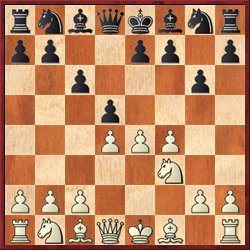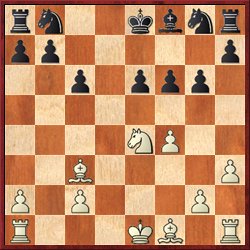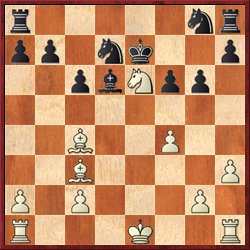Today I’m going to show you a game that I played in Reno in October — a game that began with great promise but ended with multiple blunders by me. For that reason I had not planned to blog about it, but I changed my mind for three reasons.
- It illustrates that sacrificing two pawns can often give you a better game than sacrificing one. (Hence the title of this post.)
- It follows up on a post I wrote a while ago called Why Not Nuke the Caro?
- I want to test a PGN viewer called ChessFlash. Many readers in the past have asked if I can upload my games in PGN, or show the games in an interactive window. I checked into the game viewer that you can get at chess.com, but it seemed to allow only one width, too wide for the format of this blog. However, after taking a look at what other bloggers use, I finally found a customizable viewer. I hope that this experiment works! Let me know whether you are able to play through the game successfully.
Here is the game:
And here is the PGN file.
Comments:
Position after 4. d4!?
4. d4!?: Readers of this blog know that I have been experimenting with this type of pawn sacrifice ever since my game against David Pruess, and in my post mentioned above I suggested it could be used against the Caro. Here the extra moves d4 and … g6 have been inserted. This is significant because Black could attempt to hold on grimly to the pawn with 4. … de 5. Ng5 f5. White unfortunately no longer has the lever d2-d3 to loosen Black’s grip on e4. Nevertheless, I think that White still has a good game after 6. Bc4 Nh6 7. a4 Bg7 8. c3 because it is not exactly easy for Black to get his pieces out, and White has plans like Qb3 or Na3 followed by Ba2 and Nc4, all of which put his pieces on great squares.
Interestingly, my IM opponent chose not to accept the pawn sac. Most IMs, I think, would be unhappy playing a totally defensive line like the one I just mentioned.
5. h3?!: I wasn’t sure yet whether I wanted to offer a pawn sac with 5. Nc3 de 6. Nxe4 Bxg4 7. Qxf3 Qxd4. However, as you can see this would have been even better than the game continuation, because Black has not played … e6 yet. I definitely should have played 5. Nc3.
6. … e6?!: I see no reason why Black shouldn’t take on e4, exposing my queen to attack. He lets me get away with my mistake on move 5.
8. Nxe4!: Of course!
9. Bd2!: By offering a second pawn, White gets a much bigger initiative than he would after just one pawn.
Position after 9. … Qxb2.
10. Qc3!: I think that Black must have overlooked or underestimated this move. Of course 10. Bc3? fails to 10. … Bb4, but here White would get monstrous play for the exchange ifBlack played 10. … Bb4? 11. Qxb4 Qxa1+ 12. Kf2. So Black is forced to trade queens. However, this in no way reduces White’s compensation for the two pawns!
Position after 11. … f6.
12. Ng5: Here is where I started to lose the thread. So far I’ve been playing very well, and the most natural continuation is simply to continue developing with 12. Bc4. I ruled out this move for a completely stupid reason: After 12. … Nd7 13. Bxe6 O-O-O I missed the fact that the d7 knight was pinned, so that White can win back his second pawn with 14. Nxf6 and a better game. Black has other options than 12. … Nd7, such as 12. … Ke7, but after 13. O-O-O I would be very happy.
Instead I played 12. Ng5, and after the game I was kicking myself for playing this “coffeehouse” move, moving an already-developed piece instead of bringing out a new one. However, after analyzing the game carefully, I think that 12. Ng5 was not a mistake! On e6 the knight is a tower of strength, defending f4 and preventing Black from castling. It was my later play that was at fault.
Position after 15. … Nb6
16. O-O?: Now this is the move I really wish I could take back. What possessed me? Why didn’t I play the obviously stronger 16. O-O-O, which immediately centralizes one rook and prepares to centralize the other?
If Black plays the same plan as in the game with 16. O-O-O Nb6 17. Bb3 (17. Rhe1? is too reckless: after 17. … Nxc4 18. Nc7+ Kf7! 19. Nxa8 Ne7 White’s knight gets trapped) 17. … Nd5 18. Bxd5 cd 19. Re1 White is already threatening to take on d5 — unlike in the game. It’s true that Black can hang on with 19. … Ba3+ 20. Bb2 Bxb2+ 21. Kxb2 Kd6, but after 22. c4! I would rather be White.
The only reason I can think of for why I didn’t castle long was that I was afraid of … Ba3+ at some point, but as we can see in the above variation, that is nothing to be afraid of and in some cases it actually helps White.
After 16. O-O White’s position gradually deteriorated because there was no obvious way to break through in the center.
Black’s 19. … h6! was an excellent move, with the idea of developing the rook at h7. After that the knight on g8, because it is not in the way of anything, is actually “developed” on its home square. (Reminiscent of Michael Surtees’ “Revolutionary Opening Theory”!)
White’s 20. Rd1? was too little, too late. Note how slowly I have centralized my rooks, compared to the 16. O-O-O variation above. The best try was 20. f5, but I think that White does not have full compensation for the pawn after 20. … gf 21. Rxf5 Re8! 22. Nf4 Rxe2 23. Nxe2 Bc5+.
The rest is really a massacre, but I would also like to commend Black’s 22. … Re4!, which shows how doubled pawns can often become a strength rather than a weakness. You can use the threat to undouble them as a way to double rooks on an adjacent file.
How did you like the flash viewer? Did it improve your enjoyment of this post? Let me know!







{ 7 comments… read them below or add one }
I loved the flash viewer. Worked great for me on Chrome browser. It makes a big difference. And, as one of your readers that requested this feature, I _especially_ love that you took the time to make it happen!
Another problem with 10 … Bb4 is 11 Qxb2, giving White more than sufficient compensation for the two pawns.
D’oh!
Nice game! The flash viewer with the layout to display variations is quite good.
I wanted to let you know that your opening ideas really got me thinking on how I could develop my own opening plans. That’s why I started, a few weeks ago, planning an opening novelty. I’ve already showed Gjon, and if you want, I can show it to you sometime.
Cheers,
Alex
One opening idea I’ve played around with is a pawn sac in the Caro-Kann.
1. e4 c6 2. d4 d5 3. Nc3 dxe4 4. Bc4 Nf6 5. f3
White doesn’t objectively have enough for the pawn but there’s an unpleasant trap that can make this a decent line to play in blitz. The trap is:
5. … exf3 6. Nxf3 Bg4? 7. Ne5! when white achieves a near winning position. Black is forced to play the ugly 7. … Be6 when 8. Bxe6 wrecks the cover in front of black’s king.
Actually, this line has apparently been played before but I came up with it independently. I suppose it’s almost impossible in this day and age to invent a truly unique line that literally no one has played before.
Matt,
I found a truly unique line that no one has played before 😉
You might try the Chess.com viewer http://www.chess.com/analysis-board-editor.html – go to game editor and get the “embed” code after putting the game in.
Seems to do everything the flash viewer does but it also mobile device friendly. 🙂
{ 1 trackback }